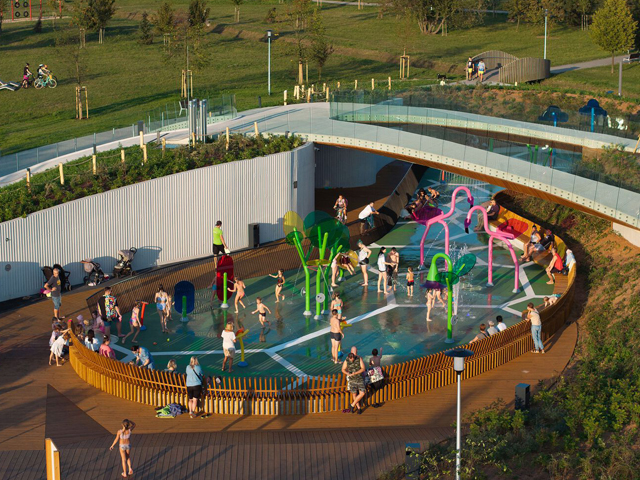HOW TO DESIGN PLAYGROUNDS THAT ENGAGE WHOLE COMMUNITIES
14 Dec 2022
The days of making lifelong friends at the playground can be the fondest in a child’s memory. So, despite the rise of online socialising replacing some of that physical playtime, adventure+ remains passionate about playground design that keeps communities thriving.

Any communal outdoor space with play equipment and facilities that cater for all age groups creates the perfect environment for community members to meet and develop their physical, social and mental health.
These areas allow growing children to explore, socialise and develop skills in an unstructured environment. As children play at a playground, they learn to make friends, take turns, share with others, and much more. Not to mention parents and guardians have the chance to mingle with other caretakers.
So, who and what should consider if you’re creating a playground that engages whole communities?
Babies and Toddlers
We find one of the biggest concerns expressed by parents is that the youngest children get overlooked in playgrounds. Too often, playground equipment is focused on school-aged children and is too difficult for the littlest ones to explore.
Playground elements that are low-level and have easy access are important for toddlers. Including a staircase instead of a challenging rope ladder for access to a slide is a simple example. Sensory and imaginative play elements, such as interactive panels, are perfect for very young children, and allow them to develop the critical cognitive function they’ll need as they grow.
Separating these simple elements from more senior play elements can help make the playground less daunting for some very young children. Senior and junior play areas don’t need to be miles apart, but distinct areas can make children feel more comfortable. When junior and senior play areas are separate, but within eyesight of each other, siblings can stay close while accessing the right level of challenge for them.
Catering for babies in a play space really comes down to making the parents feel comfortable. Nice grassy spots and tables and chairs are one way to do this.
Junior & Senior Children
Having developed their primary cognitive abilities years earlier, older children from around ages five to twelve can start tackling more active play with more challenging elements.
Higher components such as towers or centre mast rope structures encourage more strenuous physical activity while engaging their problem-solving abilities.
As they grow more confident with their friends and new people, older children should be encouraged to focus on a social and collaborative play like multi-rockers or ninja courses where healthy competition is possible. 
Catering for Parents and Carers
As we mentioned, some carers will be handling babies while they watch their older children, so tables and benches within the playground site are essential.
Zooming out, easy parking and pathways should provide access to prams, bikes, and scooters and is a regulation in some Councils.
Ensure to provide shaded areas for carers and tired children to shield them from the sun and rain.
Looking even wider, if it’s possible to build your community playground nearby to somewhere inviting for parents are carers – such as a café, library or simple amenities like toilets – this should be a priority.
Catering to Fitness Communities
These days, you’ll be hard-pressed to find a suburb without a playground that includes a workout station. Basic workouts can be completed using just the simplest of equipment, so these elements are something that can be considered.
Pull-up bars, balance beams, running tracks for joggers, and basketball courts are all great additions to keep the community fit and healthy.
Catering to Disabled Users
Any modern playground should consider children of all abilities, including those with physical, cognitive, or social disabilities.
This includes ramps and transfer points, wheelchair carousels and sensory elements like a music panel, pathways for mobility around the playground, and quiet timeout areas. 
Including the Community in the Design
No one knows more about the community’s needs than its citizens. Reaching out to members of the community is invaluable when deciding what elements to include in your project. Playground design isn’t a solitary process — nor should it be.
Collective community minds will identify strengths and weaknesses in proposed and developing plans. Engaged community members are more likely to voice likes and dislikes, so it’s essential to make them feel heard.
Consult adventure+
Once the community is on board with the idea of a new or renovated playground, get in touch with adventure+ via our website. We have the equipment and expertise to turn your bare parkland into a beautiful play space.
Find out more information from adventure+, via the links below.

MORE NEWS

MAKING A SPLASH

HOW PLAYCO PLAYGROUND MARKINGS ENHANCE PLAY, LEARNING AND SAFETY

CHINA'S NEWEST ARIA: THE HUACHIAO VIBRANT SPORTS PARK

HOW TO ENSURE YOUR DESIGN COMPLEMENTS THE SURROUNDING ARCHITECTURE

5 IDEAS HOW TO USE PLAY SPACE SLOPES TO YOUR ADVANTAGE

